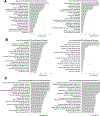Genome-wide Kdm4 histone demethylase transcriptional regulation in Drosophila
- PMID: 31020413
- PMCID: PMC6813854
- DOI: 10.1007/s00438-019-01561-z
Genome-wide Kdm4 histone demethylase transcriptional regulation in Drosophila
Abstract
The histone lysine demethylase 4 (Kdm4/Jmjd2/Jhdm3) family is highly conserved across species and reverses di- and tri-methylation of histone H3 lysine 9 (H3K9) and lysine 36 (H3K36) at the N-terminal tail of the core histone H3 in various metazoan species including Drosophila, C.elegans, zebrafish, mice and humans. Previous studies have shown that the Kdm4 family plays a wide variety of important biological roles in different species, including development, oncogenesis and longevity by regulating transcription, DNA damage response and apoptosis. Only two functional Kdm4 family members have been identified in Drosophila, compared to five in mammals, thus providing a simple model system. Drosophila Kdm4 loss-of-function mutants do not survive past the early 2nd instar larvae stage and display a molting defect phenotype associated with deregulated ecdysone hormone receptor signaling. To further characterize and identify additional targets of Kdm4, we employed a genome-wide approach to investigate transcriptome alterations in Kdm4 mutants versus wild-type during early development. We found evidence of increased deregulated transcripts, presumably associated with a progressive accumulation of H3K9 and H3K36 methylation through development. Gene ontology analyses found significant enrichment of terms related to the ecdysteroid hormone signaling pathway important in development, as expected, and additionally previously unidentified potential targets that warrant further investigation. Since Kdm4 is highly conserved across species, our results may be applicable more widely to other organisms and our genome-wide dataset may serve as a useful resource for further studies.
Keywords: Development; Drosophila; Epigenetics; Histone; Histone methylation; Kdm4.
Conflict of interest statement
Compliance with ethical standards
Conflict of interest The authors declare that there is no conflict of interest.
Figures




Similar articles
-
Drosophila Kdm4 demethylases in histone H3 lysine 9 demethylation and ecdysteroid signaling.Sci Rep. 2013 Oct 8;3:2894. doi: 10.1038/srep02894. Sci Rep. 2013. PMID: 24100631 Free PMC article.
-
The oncogenic potential of Jumonji D2 (JMJD2/KDM4) histone demethylase overexpression.Biochem Cell Biol. 2013 Dec;91(6):369-77. doi: 10.1139/bcb-2012-0054. Epub 2012 Dec 5. Biochem Cell Biol. 2013. PMID: 24219278 Review.
-
Evolution and conservation of JmjC domain proteins in the green lineage.Mol Genet Genomics. 2016 Feb;291(1):33-49. doi: 10.1007/s00438-015-1089-4. Epub 2015 Jul 8. Mol Genet Genomics. 2016. PMID: 26152513
-
The KDM4/JMJD2 histone demethylases are required for hematopoietic stem cell maintenance.Blood. 2019 Oct 3;134(14):1154-1158. doi: 10.1182/blood.2019000855. Epub 2019 Aug 21. Blood. 2019. PMID: 31434704 Free PMC article.
-
Understanding histone H3 lysine 36 methylation and its deregulation in disease.Cell Mol Life Sci. 2019 Aug;76(15):2899-2916. doi: 10.1007/s00018-019-03144-y. Epub 2019 May 30. Cell Mol Life Sci. 2019. PMID: 31147750 Free PMC article. Review.
Cited by
-
The Epigenetics of Aging in Invertebrates.Int J Mol Sci. 2019 Sep 13;20(18):4535. doi: 10.3390/ijms20184535. Int J Mol Sci. 2019. PMID: 31540238 Free PMC article. Review.
-
Growth phase diets diminish histone acetyltransferase Gcn5 function and shorten lifespan of Drosophila males.EMBO Rep. 2025 Aug;26(15):3856-3888. doi: 10.1038/s44319-025-00503-8. Epub 2025 Jul 10. EMBO Rep. 2025. PMID: 40640422 Free PMC article.
-
JMJD family proteins in cancer and inflammation.Signal Transduct Target Ther. 2022 Sep 1;7(1):304. doi: 10.1038/s41392-022-01145-1. Signal Transduct Target Ther. 2022. PMID: 36050314 Free PMC article. Review.
-
Histone Methylation Participates in Gene Expression Control during the Early Development of the Pacific Oyster Crassostrea gigas.Genes (Basel). 2019 Sep 10;10(9):695. doi: 10.3390/genes10090695. Genes (Basel). 2019. PMID: 31509985 Free PMC article.
-
KDM4 Involvement in Breast Cancer and Possible Therapeutic Approaches.Front Oncol. 2021 Oct 28;11:750315. doi: 10.3389/fonc.2021.750315. eCollection 2021. Front Oncol. 2021. PMID: 34778065 Free PMC article. Review.
References
MeSH terms
Substances
Grants and funding
LinkOut - more resources
Full Text Sources
Molecular Biology Databases
Miscellaneous

